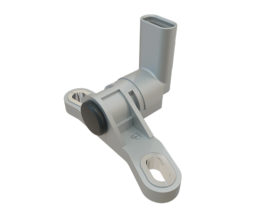Engine control – Bidirectionnal crankshaft sensor-metallic target wheel
Application description :
A crank sensor is used in an internal combustion engine to monitor the position or rotational speed of the crankshaft. This information is used by engine management systems to control ignition system timing and other engine parameters. The crank sensor is used to «synchronize» a four stroke engine upon starting, allowing the management system to determine when to inject the fuel.
It is also used in combination with a similar camshaft position sensor to monitor the relationship between the positions of the pistons and valves in the engine, which is particularly important in engines with variable valve timing.This sensor, among others functions, is commonly used as the primary source for the measurement of engine speed in revolutions per minute.
This data sheet deals with a sensor opposite a metallic trigger wheel. For a system including a magnetic trigger wheel, please refer to the corresponding datasheet. (Sensor with magnetic target).
Technical characteristics :
- Digital output with speed and direction information
- True zero speed capability – Airgap independent switching point (Zero crossing)
- Highly repeatable across operating temperature range
- Stop & start capability
- High immunity to run out and tooth to tooth variation
- Open collector output
- Robust test coverage capability using Scan Path and IDDQ measurement
- EMC full compliant


